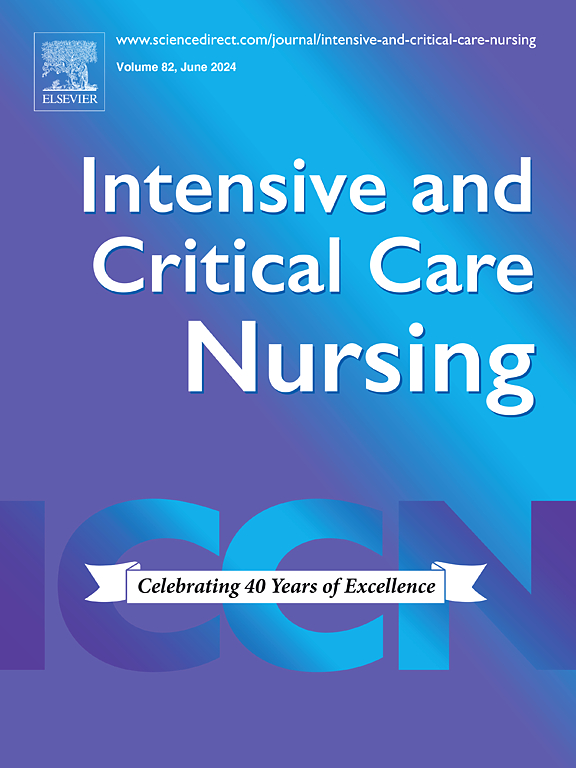Effect size estimates of risk factors for post-intensive care syndrome: A systematic review and meta-analysis
IF 4.9
2区 医学
Q1 NURSING
引用次数: 0
Abstract
Objective
To provide updated evidence on the risk factors and accurately quantify the effect size of the risk factors associated with post-intensive care syndrome (PICS), encompassing cognitive, mental, physical and socio-economic domains.
Research methodology
We conducted a systematic review of literature from January 2010 to October 2023. The meta-analysis was conducted to calculate an effect size for every risk factor, and odds ratio and 95% confidence intervals were used as summary statistics.
Results
Of 67,468 retrieved studies, 160 were included in qualitative synthesis, 102 were included in quantitative synthesis. A total of 60 factors were identified, categorized into 17 person-related, 23 disease-related and 20 ICU-related categories. The strongest correlations with cognitive health were observed for previous cognitive problems, sedatives and delirium. Factors most strongly correlated with mental health included previous mental problems, delirium, lack of social support, illicit drug and bad experience in ICU. The strongest correlations with physical health involved previous mental problem, delirium, organ dysfunction of neurologic and respiratory support. For socio-economic domains, older age and female were identified as significant risk factors.
Conclusions
This systematic review and meta-analysis identified and quantified the person, disease, and ICU-related risk factors associated with PICS. These findings may enable clinicians to better recognize the patient at high risk for PICS at an early stage during their stay in ICU.
Implications for clinical practice
A thorough investigation of risk factors across the four domains of PICS is necessary to gain a holistic understanding.
The identification and integration of risk factors associated with PICS empower critical care multidisciplinary teams to optimize management strategies, thereby assisting ICU survivors a better recovery.
Since multiple risk factors may be simultaneously associated with the four domains of post-intensive care syndrome, it is imperative to develop a comprehensive prediction algorithm.
重症监护后综合征风险因素的效应大小估计:系统回顾和荟萃分析。
目的:提供与重症监护后综合征(PICS)相关的风险因素的最新证据,并准确量化与重症监护后综合征(PICS)相关的风险因素的效应大小,包括认知、精神、身体和社会经济领域:我们对 2010 年 1 月至 2023 年 10 月期间的文献进行了系统回顾。研究方法:我们对 2010 年 1 月至 2023 年 10 月的文献进行了系统综述,通过荟萃分析计算了每个风险因素的效应大小,并使用几率比和 95% 置信区间作为汇总统计:在检索到的 67468 项研究中,160 项被纳入定性综合,102 项被纳入定量综合。共确定了 60 个因素,分为 17 个与人相关、23 个与疾病相关和 20 个与重症监护病房相关的类别。与认知健康相关性最强的是既往认知问题、镇静剂和谵妄。与心理健康相关性最强的因素包括既往的心理问题、谵妄、缺乏社会支持、非法药物和在重症监护室的不良经历。与身体健康关系最密切的因素包括既往精神问题、谵妄、神经和呼吸支持器官功能障碍。在社会经济领域,年龄较大和女性被认为是重要的风险因素:本系统综述和荟萃分析确定并量化了与 PICS 相关的个人、疾病和 ICU 相关风险因素。这些发现可帮助临床医生在病人入住重症监护病房的早期阶段更好地识别PICS的高风险病人:对临床实践的启示:为了全面了解 PICS,有必要对其四个领域的风险因素进行彻底调查。识别并整合与 PICS 相关的风险因素,可帮助重症监护多学科团队优化管理策略,从而帮助 ICU 幸存者更好地康复。由于多种风险因素可能同时与重症监护后综合征的四个领域相关,因此开发一种全面的预测算法势在必行。
本文章由计算机程序翻译,如有差异,请以英文原文为准。
求助全文
约1分钟内获得全文
求助全文
来源期刊

Intensive and Critical Care Nursing
NURSING-
CiteScore
6.30
自引率
15.10%
发文量
144
审稿时长
57 days
期刊介绍:
The aims of Intensive and Critical Care Nursing are to promote excellence of care of critically ill patients by specialist nurses and their professional colleagues; to provide an international and interdisciplinary forum for the publication, dissemination and exchange of research findings, experience and ideas; to develop and enhance the knowledge, skills, attitudes and creative thinking essential to good critical care nursing practice. The journal publishes reviews, updates and feature articles in addition to original papers and significant preliminary communications. Articles may deal with any part of practice including relevant clinical, research, educational, psychological and technological aspects.
 求助内容:
求助内容: 应助结果提醒方式:
应助结果提醒方式:


